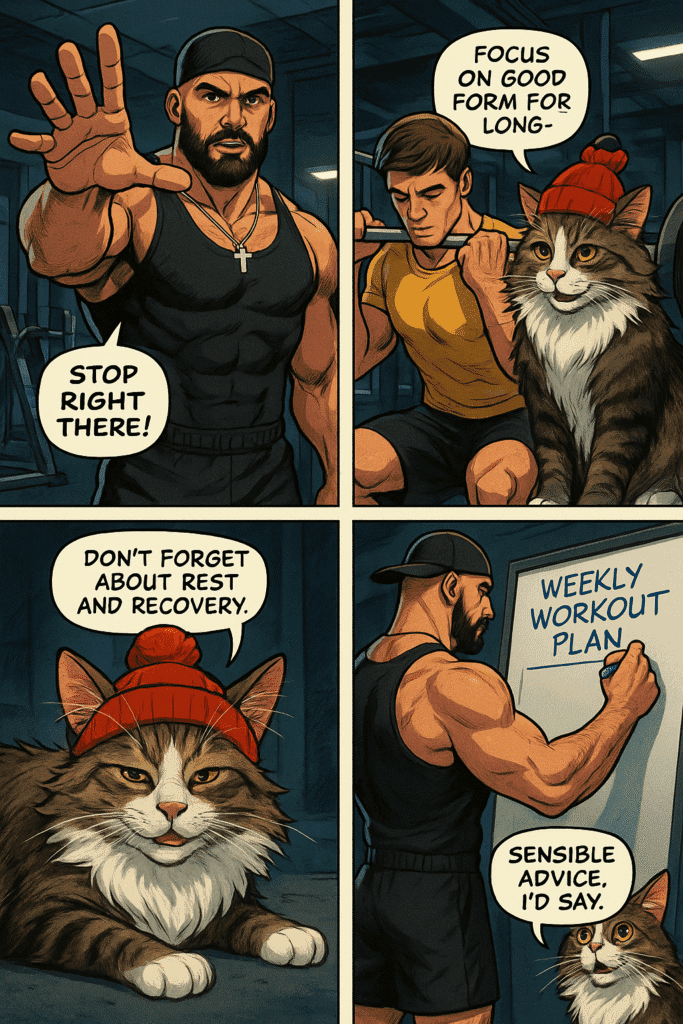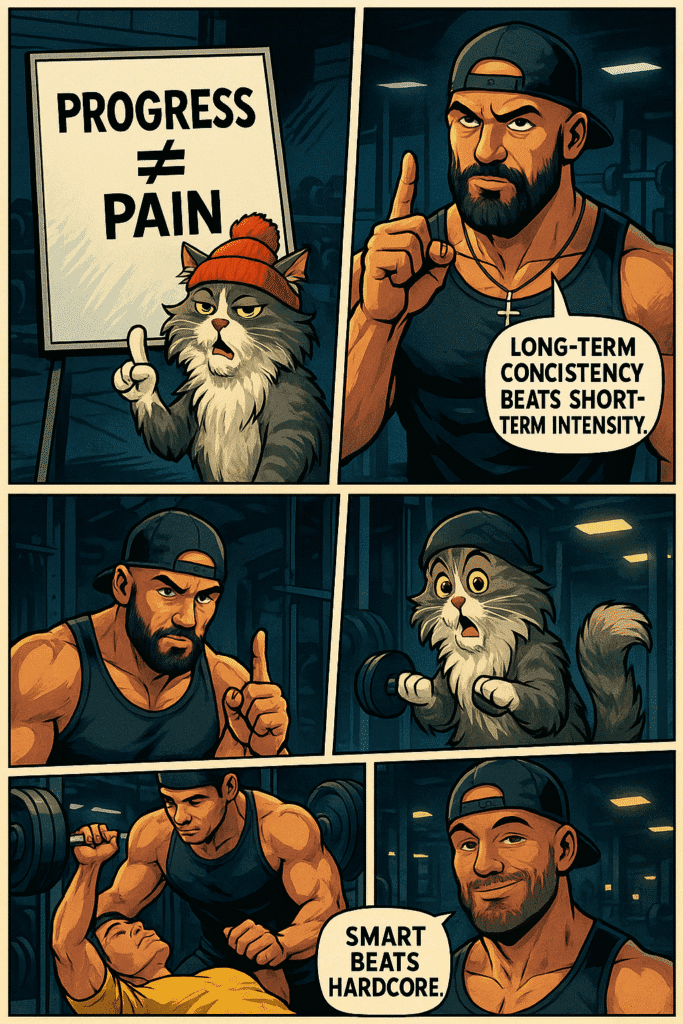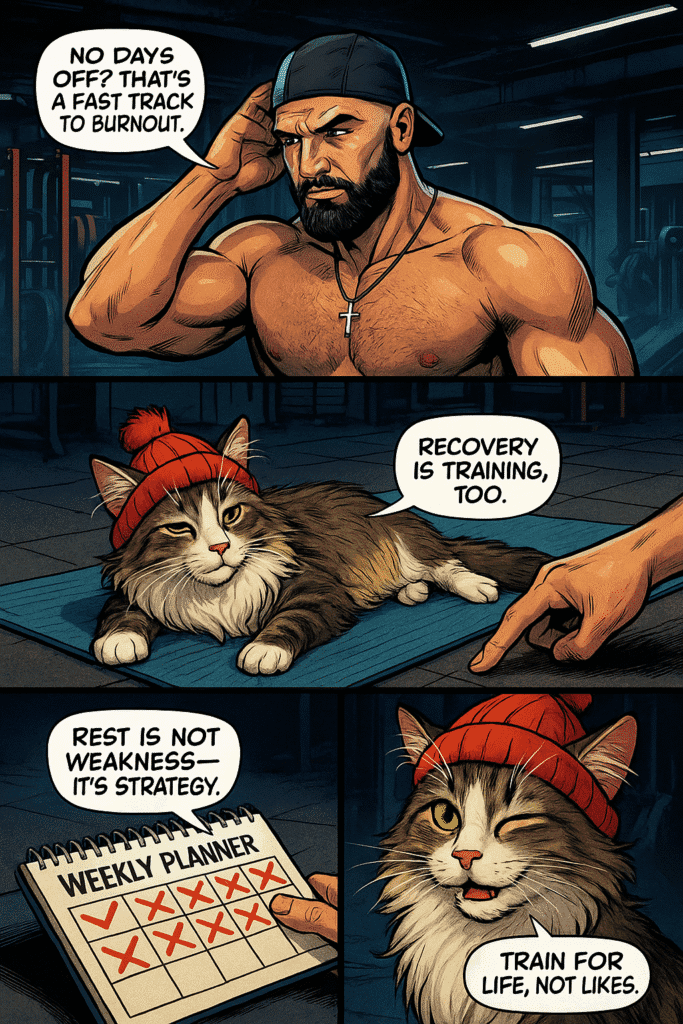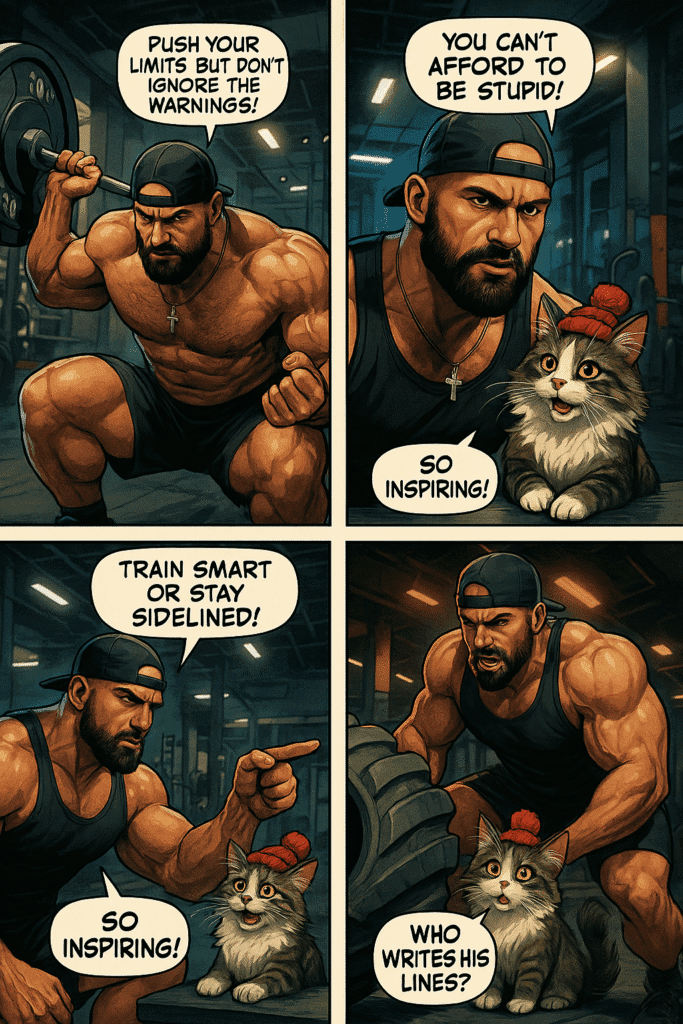If you’re serious about getting fit at home, injury prevention home workout strategies should be the first thing on your checklist—not an afterthought. I’ve seen it too many times: someone starts strong, skips a few essentials, and ends up benched with a pulled back or tweaked shoulder. Sound familiar? Let’s make sure that’s not you.
⚠️ Why Most Home Workouts Fail (And Hurt)
Working out from home seems simple—until your knees, elbows, or spine start filing complaints. Unlike a gym, you don’t have mirrors, trainers, or even proper flooring. That means you need to take full responsibility for your setup and your body. Here’s where most people screw it up:
- No warm-up: Jumping into burpees cold is like driving a car at full speed without oil.
- Terrible form: YouTube is helpful… but not when you’re imitating a shredded 22-year-old doing circus moves.
- Too much, too soon: 100 push-ups on day 1 is not a flex—it’s a recipe for wrecked shoulders.

Real talk: I once had a client—38, ambitious, full of fire—who pulled his hamstring during an Instagram “Follow-Along” workout because he didn’t warm up. Took him six weeks to walk without pain. That’s six weeks of lost momentum. Don’t be that guy.
“Success is the sum of small efforts, repeated day in and day out.”
– Robert Collier
🔥 Warm-Up Like You Mean It
Look, skipping your warm-up is like going into battle without armor. A proper warm-up increases blood flow, activates stabilizer muscles, and preps your nervous system. Here’s a simple structure that’ll save your joints and skyrocket your performance:
- Dynamic Mobility: Arm circles, leg swings, cat-cow—get the joints moving.
- Light Cardio: 3–5 minutes of jumping jacks or jogging in place.
- Activation Work: Glute bridges, bird dogs, or band pulls to wake up sleepy muscles.

Don’t just warm up—own it. Make it a non-negotiable ritual.
| Common Mistake | Better Alternative |
|---|---|
| Skipping warm-up | 5-min dynamic mobility + cardio |
| Max reps from Day 1 | Gradual progression with control |
| No feedback on form | Use a mirror or record yourself |
Want to go deeper into mobility and pain-free training? Check out our guide to joint-friendly home workouts. (This article’s link is coming soon. Meanwhile, explore other posts on the blog!)
Also worth a look: this no-fluff breakdown from PubMed on injury prevention principles and recovery basics.
We’re just getting started. In the next section, I’ll show you how to scale your workouts without wrecking your body. It’s where 80% of home lifters mess up—and I’ll make sure you’re not one of them. Stay tuned. 👊
📈 Injury Prevention Home Workout Means Smart Progression
Here’s the hard truth—injury prevention home workout plans fail when people try to go from 0 to 100. And no, adding more weight or reps every day doesn’t mean you’re leveling up. It means you’re one step closer to tweaking your lower back or frying your rotator cuff.
Progression should be smart, not savage. Your joints, tendons, and ligaments adapt slower than muscles. If you don’t respect that, your body will humble you—fast.
Take my buddy Dave, 42. Went from couch potato to “I’m doing 100 push-ups daily now.” Guess what? By week 2, he couldn’t lift his arm above shoulder height. 🙃 He skipped the slow build-up and paid the price.
Here’s how to level up the right way:
- Increase reps gradually: Think 2–3 extra reps per week, not 10+ per session.
- Add tempo or pauses: Slow down the eccentric phase or add 1-second holds at the bottom of a squat.
- Mix resistance methods: Try bands, tempo, isometrics—don’t just chase heavy weights.
“It’s not the daily increase but daily decrease. Hack away at the unessential.”
– Bruce Lee
| Unsafe Progression | Smart Alternative |
|---|---|
| Double reps every session | +2 reps per week |
| Random max-out sets | Structured volume increases |
| Ignoring pain signals | Adjusting volume/load early |
For a full breakdown on creating smart progressions, check out this detailed plan: Home Workout Scaling Without Injury. (This article’s link is coming soon. Meanwhile, explore other posts on the blog!)
Want even more science-backed advice? This PubMed explains how progressive overload, done wrong, leads to overtraining and burnout. Worth a read. 📚
🧠 Safe Training Tips: Train Smarter, Not Just Harder
Now let’s talk about form, posture, and control. AKA: the holy trinity of injury prevention home workout longevity.
When you don’t have a coach watching every rep, it’s up to you to be your own form police. And yes, that means swallowing your ego and filming your workout sometimes. I know, it feels weird—but it’s the easiest way to see that your squats are collapsing inward or your planks look like hammocks. 😅
- Use mirrors or video: Record your form once a week. Spot errors. Fix them.
- Do reps slow and clean: If you can’t do a push-up with control, stop trying clapping push-ups.
- Practice cues: Chest proud, shoulders back, brace your core—say it out loud if needed.
Client story: Lena, 36, was deadlifting with water jugs. Looked great from the front—but from the side? Rounded back, bent knees, total disaster. She fixed it by practicing Romanian deadlifts with a broomstick in front of a mirror for a week. Now? Solid form, zero pain.
That’s how you build strength that lasts. Not by doing more. By doing better.
Next up, I’ll break down how to structure your week so you’re not smashing your body into the ground. Spoiler: You need more rest than you think. 🛌 Stay tuned.
🧩 Injury Prevention Home Workout ≠ Daily Grind
Injury prevention home workout plans don’t mean pushing through soreness or training 7 days a week like you’re prepping for the Olympics. That’s one of the most damaging myths floating around in the home fitness world.
Rest isn’t laziness—it’s fuel. Muscles don’t grow during training; they grow when you rest. Same goes for tendon strength and nervous system recovery. Yet too many people ignore the signs. I had a client, Mark, 35, who trained six days straight doing HIIT, resistance bands, and bodyweight supersets. After three weeks? Shin splints, chronic fatigue, and—wait for it—zero gains. He was wrecked.
So let’s break the myth:
- Myth: “No days off” leads to faster results.
- Truth: It leads to faster burnout—and probably an injury.
- Myth: You need to feel sore to make progress.
- Truth: Soreness ≠ effectiveness. It just means your body isn’t adapted—yet.
“If you listen to your body when it whispers, you won’t have to hear it scream.”
– Dan Millman
Recovery isn’t just good—it’s mandatory. Active rest days with walks, foam rolling, or yoga keep your momentum going without crushing your system. That’s how you train for life—not just for the mirror.
| Mistake | Better Habit |
|---|---|
| Training every day, no breaks | 3–4 strength days, 2–3 active recovery days |
| Ignoring fatigue or pain | Adjust intensity and volume weekly |
| Chasing soreness | Focus on controlled, pain-free movement |
🔍 Safe Training Tips That Actually Work

Let’s get specific. What makes a safe training tip actually effective for a home setup? It’s not fancy gear, and it’s definitely not random Instagram workouts.
Real safety comes from structure, awareness, and learning from experience. Here are my golden rules:
- Never train through joint pain. Muscle discomfort? Fine. Sharp joint pain? Red light.
- Start and end with mobility. Even 5 minutes makes a huge difference in long-term joint health.
- Switch movement patterns often. Don’t just push—add pulls, hinges, and rotation.
- Respect your limits. Progression should challenge you—not cripple you.
One client of mine, Daniella, 40, kept injuring her shoulder during push-up challenges. We swapped her plan for a pull-push split with rotator cuff work and mobility drills before every session. Three weeks later? No pain, stronger push-ups, and confidence through the roof. 🙌
Want to upgrade your rest strategy for better performance? Check out this article on smart home workout recovery techniques. (This article’s link is coming soon. Meanwhile, explore other posts on the blog!)
And if you want to dive into movement science that backs this up, this breakdown from PubMed highlights the most common training errors and how to avoid them.
In the next section, I’ll show you how to wrap all these tips into a weekly structure that keeps you injury-free, energized, and making progress without guesswork. Let’s build a routine that lasts. 💪
🛠️ Injury Prevention Home Workout = Structured Weekly Routine

Let’s be real—injury prevention home workout principles mean jack if you’re training on vibes alone. Without structure, even the best safe training tips fall apart. So how do you actually apply all this in your week?
Here’s a proven, pain-proof framework that balances strength, mobility, and recovery without burning you out:
| Day | Focus |
|---|---|
| Monday | Full-body strength + mobility warm-up |
| Tuesday | Active recovery: stretching, foam rolling |
| Wednesday | Lower body strength + core stability |
| Thursday | Cardio or mobility flow (light & easy) |
| Friday | Upper body strength + posture drills |
| Weekend | 1 day off, 1 optional light movement |
I’ve used this plan with dozens of clients—from busy dads to high-performing professionals—and guess what? Fewer injuries, better consistency, and actual progress without the burnout. One guy even texted me, “Bro, I didn’t think I could get stronger without wrecking my back, but this works.” That’s the kind of feedback that hits home. 💥
“Take care of your body. It’s the only place you have to live.”
– Jim Rohn
✅ Conclusion
Here’s your no-fluff recap of how to stay injury-free while crushing it at home:
- 🔥 Warm up like a pro—always.
- 📈 Progress gradually with control and purpose.
- 🧠 Use safe training tips rooted in real science, not fads.
- 🛌 Prioritize recovery like it’s part of the workout (because it is).
- 📅 Structure your week to balance intensity and longevity.
💬 What about you? Drop a comment below and share your biggest struggle with home workouts. Let’s connect. Found this helpful? Share it with a friend who trains solo and deserves to do it pain-free.
And if you’re ready to build smarter habits, check out this plan: The Weekly Injury-Proof Home Routine.
📎 Internal Links
- The Weekly Injury-Proof Home Routine
- How to Progress Workouts Without Injury
- Top Recovery Habits for Home Athletes
- Joint-Friendly Training at Home
🔗 External Links
- PubMed: Effectiveness of a home-based re-injury prevention program on motor control, return to sport and recurrence rates after anterior cruciate ligament reconstruction: study protocol for a multicenter, single-blind, randomized controlled trial (PReP)
- PubMed: Exercise for preventing falls in older people living in the community
- PubMed: Effectiveness of a home-based balance-training program in reducing sports-related injuries among healthy adolescents: a cluster randomized controlled trial
- PubMed: Falls prevention over 2 years: a randomized controlled trial in women 80 years and older
Remember: Progress without pain is possible. You don’t need to break your body to build it. Train smart. Stay strong. And move with purpose. 💪
One day, a young warrior decided he would forge his strength at home. No armor, no plan—just raw fire in his chest and a pull-up bar from Amazon.
Day 1, he fought burpees with no warm-up. His knees cried. Day 3, he lifted weights he wasn’t ready for. His back plotted revenge. Day 7, he believed soreness was glory. His tendons filed complaints with higher powers.
Defeated, he crawled to the Wise Old Trainer and said, “Why does my body betray me?”
The Trainer smiled and answered: “Because you treated your body like a punching bag, not a temple. 🛡️”
“Train like a savage, but protect yourself like a king. Warm up like it matters. Progress like you respect the game. Listen when your body whispers—before it starts to scream.”
And from that day on, the warrior still trained hard. But he also trained *smart*. And his strength? It lasted a lifetime. 🏆


“Supplements don’t save you. Scars do.”
They call me “Capitan T”. But I was Nik before the scars.
I didn’t just search how to increase testosterone naturally. I bled for it.
This isn’t a trend piece. It’s a field report from a man who chose ritual over rest.
I’ve tried every so-called best test booster and watched which ones cracked under pressure.
If you want to boost testosterone after 30, it won’t come from hope. It starts with blood, silence, and the grind you’ve avoided.
Supplements help — but only if your rituals scream louder than your cravings.


“He bleeds. I guard the flame.”
I’m Malysh — red hat. No scroll. No lies. He tore through dopamine silence, cold rituals, and pain — just to test the fire behind every pill. Most broke. The few that survived — earned their place among the real testosterone supplements over 30.
These weren’t picked. They were proven. And if your fire’s still fake — don’t touch them.
Still scrolling? Your testosterone isn’t.
Home Gym Setup for Men Over 30: Minimalist Edition That Breaks You Back Into Power
Home gym for men 30+ — this isn’t about convenience. It’s about survival. I didn’t…
7 Proven Ways to boost testosterone after 30 and increase testosterone naturally
This isn’t a guide. It’s a scar.Because you don’t boost testosterone after 30 by reading…
Injury Prevention Home Workout: Safe Training Tips That Actually Work 💥
If you’re serious about getting fit at home, injury prevention home workout strategies should be…
Best Adaptogens for Stress Relief After 30: Unlocking Real Power, Bro
Adaptogens men stress — two words that can change your whole damn game after 30….
Sleep Optimization for Men Over 30: Science & Strategy
Better sleep men 30+ isn’t just a nice-to-have — it’s survival gear for your second…
Blood-Ritual Morning Routine Men Over 30 Swear By to Reclaim Testosterone
Your morning routine men over 30 isn’t just a habit. It’s a battlefield. And you’re…


